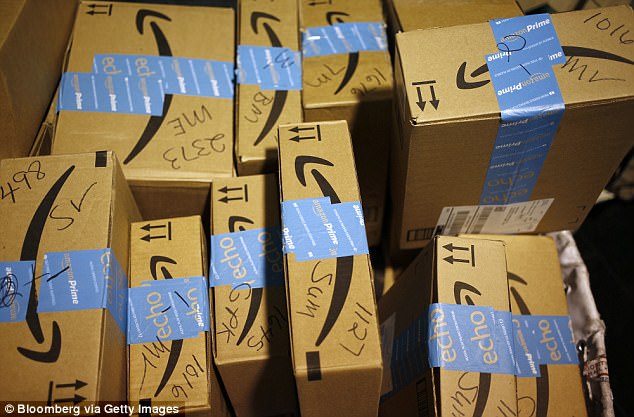
- A new report explains how the U.S. Postal Service has been practically subsidizing postage for large retailers like Amazon
- The Postal Service is barred by law from charging less than it costs to deliver a package
- But the report finds that they may be miscalculating the package side of their business
- In April, a Citigroup analysis found that the Postal Service should be charging, on average, $1.46 more on packages
- ‘It is as if every Amazon box comes with a dollar or two stapled to the packing slip – a gift card from Uncle Sam,’ Josh Sanbulte writes in the Wall Street Journal
There’s a reason Amazon packages have become a common sight on front steps around the country, and that’s because the U.S. Postal Service practically subsidizes postage for the internet giant.
As Josh Sandbulte, co-president of money management firm Greenhaven Associates, pointed out in the Wall Street Journal, the Postal Service has a legal monopoly to deliver first-class mail in the U.S. – in other words, non-urgent letters. In exchange, the Postal Service is required to deliver, if needed, mail to every address in America, six days a week.
Since the invention of email, the amount of physical mail being sent has dramatically declined, so the Postal Service has supplemented that business with package delivery.
This monopoly does not extend to packages, a corner of the market which sees companies like UPS and FedEx directly competing with the Postal Service.
In order not to give the Postal Service an unfair advantage in the package delivery market, lawmakers in 2006 passed the Postal Accountability and Enhancement Act, which made it illegal for the Postal Service to charge less for postage than what it costs to deliver a package.
Sandbulte says that the issue is that the Postal Service may be miscalculating how much it costs to deliver packages, and in turn has been undercharging clients who ship with them.
In 2007, the Postal Service and its regulator determined that, at a minimum, 5.5 per cent of the agency’s fixed costs should go towards package delivery.
Today, package delivery takes up 25 per cent of the Postal Service’s business, but its share of fixed costs has stayed the same.
That means that the Postal Service is effectively subsidizing package delivery with first-class mail.
According to an April analysis from Citigroup, if costs were fairly allocated, on average parcels would cost $1.46 more to deliver.
This, Sandbulte says, gives online retailers like Amazon – who also take advantage of discounted ‘last mile’ delivery – an unfair advantage.
‘It is as if every Amazon box comes with a dollar or two stapled to the packing slip – a gift card from Uncle Sam,’ he writes.
He continues: ‘Amazon is big enough to take full advantage of “postal injection” and that has tipped the scales in the internet giant’s favor.
‘Select high-volume shippers are able to drop off presorted packages at the local Postal Service depot for “last mile” delivery at cut-rate prices.
‘With high volumes and warehouses near the local depots, Amazon enjoys low rates unavailable to its competitors.
‘My analysis of available data suggests that around two-thirds of Amazon’s domestic deliveries are made by the Postal Service. It’s as if Amazon gets a subsidized space on every mail truck,’ he says.
Sandbulte says it’s time for lawmakers to revamp the Postal Accountability and Enhancement Act, so that the Postal Service can’t pick ‘winners and losers in the retail world’.
It should be noted that Sandbulte’s money-managing firm owns common stock in FedEx, one of the Postal Service’s competitors.
Source: DailMail.co.uk
